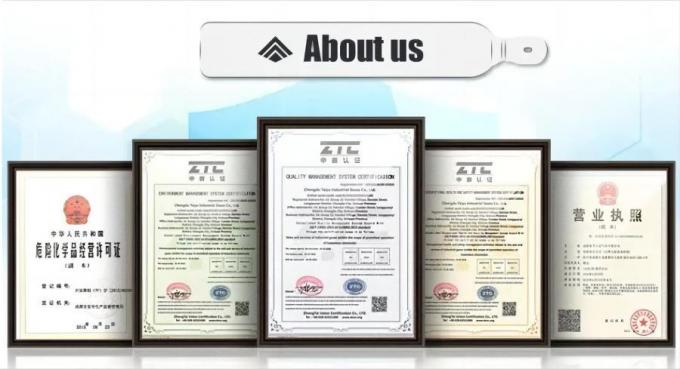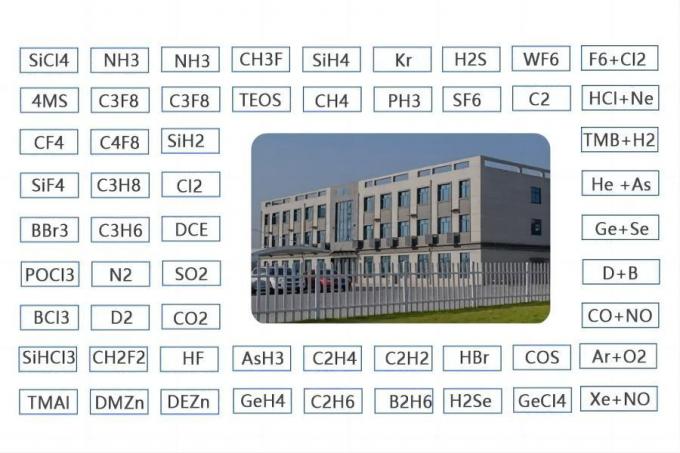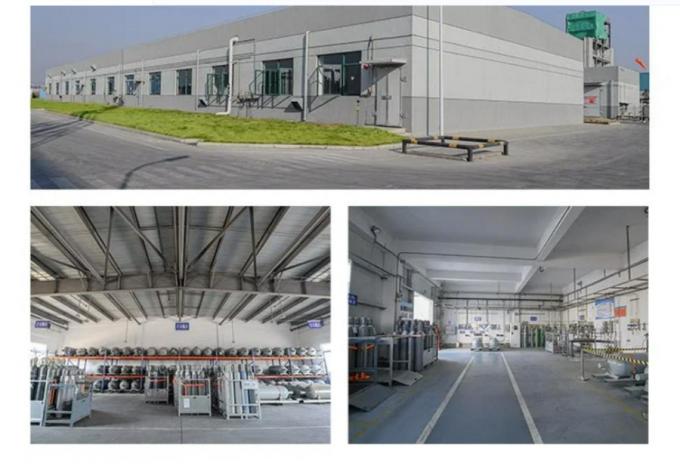


| MOQ: | 1kg |
| Price: | US $25/PC |
| Standard Packaging: | Cylinder/Tank |
| Delivery Period: | 15 days |
| Payment Method: | L/C, T/T |
| Supply Capacity: | 2000 Pcs/Month |
Acetylene gas (C2H2) is a highly flammable hydrocarbon gas that is commonly used in various industrial applications. It is a colorless gas with a distinct odor, and it is composed of two carbon atoms bonded to two hydrogen atoms. Here are some key points about acetylene gas:
Properties: Acetylene gas is highly flammable and can form explosive mixtures with air. It has a wide flammability range, meaning it can ignite and burn even at relatively low concentrations. Acetylene is lighter than air, so it can disperse and accumulate in high concentrations in poorly ventilated areas.
Production: Acetylene gas is typically produced through the reaction of calcium carbide (CaC2) with water (H2O) in a process called hydrolysis:
CaC2 + 2H2O → C2H2 + Ca(OH)2
This reaction generates acetylene gas along with calcium hydroxide as a byproduct.
Uses: Acetylene gas has several important applications:
Welding and Cutting: Acetylene is widely used as a fuel gas in oxyacetylene welding and cutting torches. When mixed with oxygen and ignited, it produces a high-temperature flame that can melt and join metals.
Chemical Synthesis: Acetylene serves as a starting material for the synthesis of various organic compounds. It is used in the production of plastics, solvents, pharmaceuticals, and other chemicals.
Lighting: Historically, acetylene gas was used in acetylene lamps for portable lighting. However, these lamps have largely been replaced by electric lighting systems.
Calibration Gas: Acetylene gas can be used as a calibration gas in analytical instruments due to its well-defined properties and stability.
Safety Considerations: Due to its flammability and potential for explosive decomposition, acetylene gas should be handled with extreme caution. It requires specific storage, transportation, and handling procedures to minimize the risk of accidents. Acetylene gas cylinders are typically filled with a porous material, such as acetone, to stabilize the gas and reduce the risk of decomposition.
When working with acetylene gas, it is crucial to follow strict safety guidelines, including using appropriate gas handling equipment, ensuring proper ventilation, and taking precautions to prevent ignition sources in the vicinity.
It's important to handle and use acetylene gas responsibly, adhering to established safety protocols to ensure the safety of personnel and the surrounding environment.
Basic Info.
| Model NO. | C2H2 | Un | 1001 |
| Hazard Class | 2.1 | Label | Common |
| Analysis Report | Certificate of Conformity | Chemical Formula | C2h2 |
| Purity | 98% | Widely Used | Electronically Conducting Plastics |
| Product Name | Acetylene | Transport Package | Cylinder/Tank |
| Specification | 40L or others | Trademark | CMC |
| Origin | Suzhou, Jiangsu, China | HS Code | 29012920 |
| Production Capacity | 2000cylinder/Month |
| Physical Index | |||
| Purity | 99.95% | Application | 1. Ripening |
| UN | UN1962 | 2. API | |
| CAS | 74-85-1 | 3. Refrigerant | |
| EINECS | 200-815-3 | ||
| Specification | ≥99.999% |
| O2 | <0.5ppm |
| N2 | <2ppm |
| H2O | <0.5ppm |
| Argon | <2ppm |
| CO2 | <0.5ppm |
| CH4 | <0.5ppm |
| XE | <2ppm |
| CF4 | <0.5ppm |
| H2 | <0.5ppm |
| Gas | Acetylene | Chemical Formula | C2H2 | |
| Hazard Class | 2.1 | Molecular Weight | 26.038 | |
| CAS | 74-86-2 | UN | 1001 | |
| Boiling Point | at 1.013 bar [ºC] | -84.15 | at 14.5 psi, [ºF] | -241.17 |
| Density | at 1.013 bar,15ºC, [kg/m³] | 1.109 | at 1 atm., 70ºF, [lb/ft³] | 0.068 |
Detailed Photos
![]()




| MOQ: | 1kg |
| Price: | US $25/PC |
| Standard Packaging: | Cylinder/Tank |
| Delivery Period: | 15 days |
| Payment Method: | L/C, T/T |
| Supply Capacity: | 2000 Pcs/Month |
Acetylene gas (C2H2) is a highly flammable hydrocarbon gas that is commonly used in various industrial applications. It is a colorless gas with a distinct odor, and it is composed of two carbon atoms bonded to two hydrogen atoms. Here are some key points about acetylene gas:
Properties: Acetylene gas is highly flammable and can form explosive mixtures with air. It has a wide flammability range, meaning it can ignite and burn even at relatively low concentrations. Acetylene is lighter than air, so it can disperse and accumulate in high concentrations in poorly ventilated areas.
Production: Acetylene gas is typically produced through the reaction of calcium carbide (CaC2) with water (H2O) in a process called hydrolysis:
CaC2 + 2H2O → C2H2 + Ca(OH)2
This reaction generates acetylene gas along with calcium hydroxide as a byproduct.
Uses: Acetylene gas has several important applications:
Welding and Cutting: Acetylene is widely used as a fuel gas in oxyacetylene welding and cutting torches. When mixed with oxygen and ignited, it produces a high-temperature flame that can melt and join metals.
Chemical Synthesis: Acetylene serves as a starting material for the synthesis of various organic compounds. It is used in the production of plastics, solvents, pharmaceuticals, and other chemicals.
Lighting: Historically, acetylene gas was used in acetylene lamps for portable lighting. However, these lamps have largely been replaced by electric lighting systems.
Calibration Gas: Acetylene gas can be used as a calibration gas in analytical instruments due to its well-defined properties and stability.
Safety Considerations: Due to its flammability and potential for explosive decomposition, acetylene gas should be handled with extreme caution. It requires specific storage, transportation, and handling procedures to minimize the risk of accidents. Acetylene gas cylinders are typically filled with a porous material, such as acetone, to stabilize the gas and reduce the risk of decomposition.
When working with acetylene gas, it is crucial to follow strict safety guidelines, including using appropriate gas handling equipment, ensuring proper ventilation, and taking precautions to prevent ignition sources in the vicinity.
It's important to handle and use acetylene gas responsibly, adhering to established safety protocols to ensure the safety of personnel and the surrounding environment.
Basic Info.
| Model NO. | C2H2 | Un | 1001 |
| Hazard Class | 2.1 | Label | Common |
| Analysis Report | Certificate of Conformity | Chemical Formula | C2h2 |
| Purity | 98% | Widely Used | Electronically Conducting Plastics |
| Product Name | Acetylene | Transport Package | Cylinder/Tank |
| Specification | 40L or others | Trademark | CMC |
| Origin | Suzhou, Jiangsu, China | HS Code | 29012920 |
| Production Capacity | 2000cylinder/Month |
| Physical Index | |||
| Purity | 99.95% | Application | 1. Ripening |
| UN | UN1962 | 2. API | |
| CAS | 74-85-1 | 3. Refrigerant | |
| EINECS | 200-815-3 | ||
| Specification | ≥99.999% |
| O2 | <0.5ppm |
| N2 | <2ppm |
| H2O | <0.5ppm |
| Argon | <2ppm |
| CO2 | <0.5ppm |
| CH4 | <0.5ppm |
| XE | <2ppm |
| CF4 | <0.5ppm |
| H2 | <0.5ppm |
| Gas | Acetylene | Chemical Formula | C2H2 | |
| Hazard Class | 2.1 | Molecular Weight | 26.038 | |
| CAS | 74-86-2 | UN | 1001 | |
| Boiling Point | at 1.013 bar [ºC] | -84.15 | at 14.5 psi, [ºF] | -241.17 |
| Density | at 1.013 bar,15ºC, [kg/m³] | 1.109 | at 1 atm., 70ºF, [lb/ft³] | 0.068 |
Detailed Photos
![]()


